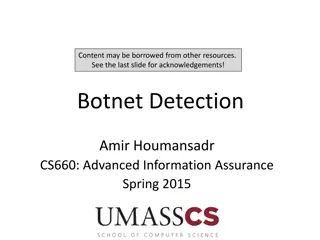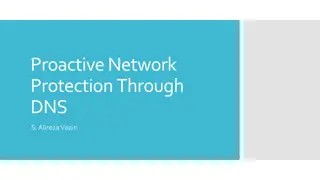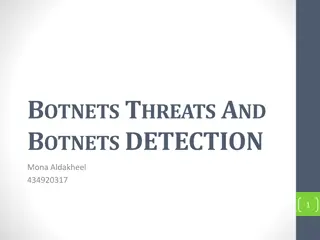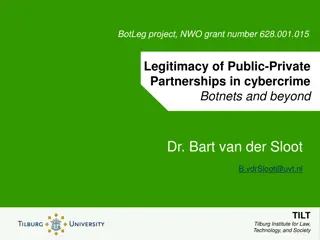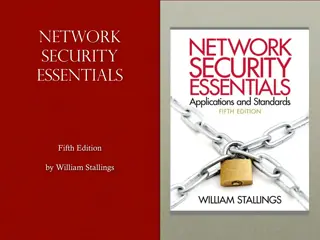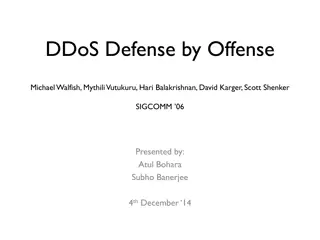Understanding Botnets: A Threat to Cybersecurity
Explore the world of botnets, malware instances that operate on compromised computers without consent. Learn about the structure of botnets, the role of Command and Control channels, and the top botnets like Zeus and Koobface. Discover the widespread impact of botnets and the need for robust detecti
0 views • 33 slides
Automated Signature Extraction for High Volume Attacks in Cybersecurity
This research delves into automated signature extraction for high-volume attacks in cybersecurity, specifically focusing on defending against Distributed Denial of Service (DDoS) attacks. The study discusses the challenges posed by sophisticated attackers using botnets and zero-day attacks, emphasiz
0 views • 37 slides
Proactive Network Protection Through DNS Security Insights
Exploring proactive network protection methods using DNS, security challenges, botnet threats, firewall management, malware controls, and DNS-based malware control. Discussions on DNS security vulnerabilities, DNSSEC, threat intelligence, machine learning, and best practices like RPZ for DNS protect
0 views • 29 slides
Understanding Botnets: Threats, Detection, and Control Techniques
Explore the world of botnets, learn about the creation, propagation, and command & control techniques used by malicious actors. Discover the security threats posed by botnets and methods to detect and mitigate them effectively. Images and detailed explanations provide insights into handling bot-rela
0 views • 31 slides
Exploring Legitimacy and Public-Private Partnerships in Cybercrime Enforcement
Investigate the legitimacy of public-private partnerships in addressing cybercrime, focusing on botnets and related issues. The study examines the classic model of legitimacy involving the state, citizens, and the market, and explores different stakeholders' roles in ensuring legitimacy in enforceme
0 views • 14 slides
Effective DGA Family Classification using Hybrid Inspection Technique on P4 Switches
Attackers utilize Domain Generation Algorithms (DGAs) as dynamic communication methods in malware like botnets and ransomware to evade firewall controls. This study presents a novel approach that combines shallow and deep packet inspection on P4 Programmable Switches for efficient classification of
0 views • 19 slides
Understanding Malicious Software: Classification and Payload Actions
Malicious software, or malware, can be broadly classified based on how it spreads and the actions it performs once on a target system. This classification includes distinctions between viruses, worms, trojans, botnets, and blended attacks. The payload actions of malware can range from file corruptio
0 views • 44 slides
Understanding DDoS Attacks and Defense Strategies
In computing, DDoS attacks aim to disrupt machine or network services by overwhelming resources. This article delves into the concept of DDoS, application-level attacks, botnets, defense mechanisms like profiling and rate-limiting, and the effectiveness of the "Speak-Up" approach in mitigating DDoS
0 views • 26 slides
